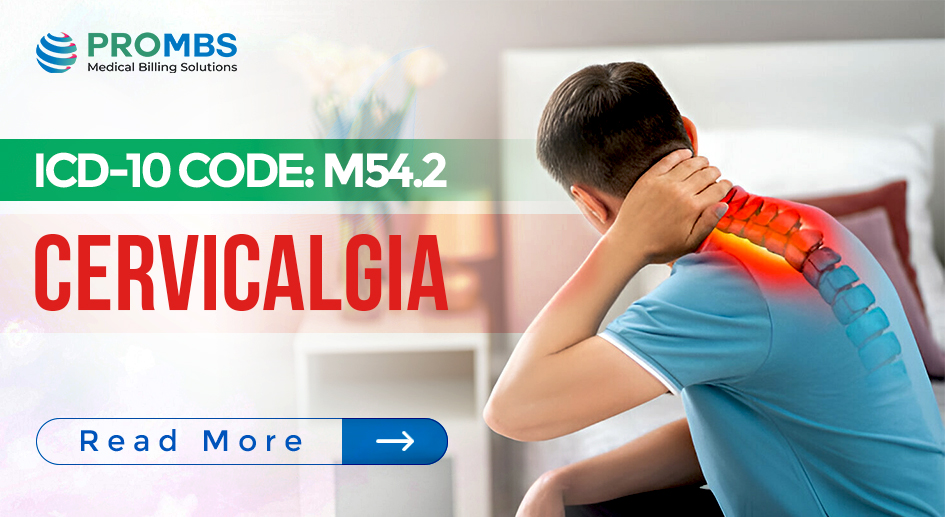Cervicalgia ICD-10 Code M54.2:Guide for Accurate Medical Billing
Cervicalgia, or neck pain, is one of the most frequently reported musculoskeletal complaints in medical practices. Whether caused by posture, injury, or aging, neck pain requires accurate documentation and coding for proper reimbursement. The ICD-10 code for neck pain, M54.2 cervicalgia, is essential for capturing this diagnosis correctly. Understanding how and when to use it can help ensure clean claims and faster payments.
Key Points
- ICD-10 Code: M54.2
- Definition: Cervicalgia refers to non-radiating neck pain
- Billable: Yes
- Used For: Office visits, chiropractic care, physical therapy, and pain management
- Common Causes: Muscle strain, poor posture, whiplash, arthritis, herniated disc (without nerve involvement)
- Excludes: Radiating pain due to nerve roots irritation (e.g., cervical radiculopathy, spinal cord compression)
- Documentation Must Include: Onset, symptom type, duration, limitations, and clinical findings
What Is Cervicalgia?
Cervicalgia is the clinical term for localized neck pain in the cervical spine. It does not involve pain radiating to the arms or hands, which would be coded differently. This condition may result from:
- Poor ergonomics or posture
- Sudden jerking movements
- Muscle overuse or strain
- Stress-related muscle tension
- Degenerative joint conditions
- Mild herniated disc without neurological compromise
If left untreated, acute pain can develop into chronic neck pain, impacting mobility and quality of life.
Examples of Neck Pain Symptoms
- Constant dull ache or tightness in the neck
- Difficulty turning the head side to side
- Tenderness in neck muscles
- Pain that worsens with certain movements
- Tension headaches originating from the neck
- Stiffness after sleep or prolonged sitting
ICD-10 Code for Cervicalgia: M54.2
| ICD-10 Code | Description | Billable | Category |
|---|---|---|---|
| M54.2 | Cervicalgia (Neck Pain) | Yes | Musculoskeletal system |
This code belongs to Chapter 13 of ICD-10-CM, which covers musculoskeletal system and connective tissue disorders. It is used for reimbursement when the patient’s diagnosis is neck pain without nerve roots involvement.
When to Use ICD-10 Code M54.2
Use this code when the patient presents with localized neck pain without radiating symptoms. Physical examination or imaging should confirm the absence of nerve roots compression or spinal cord injury. This includes cases caused by poor posture, repetitive movement, or muscular strain.
If pain radiates or is linked to herniated disc with neurological findings, select a more specific diagnosis code.
Coding Tips for ICD-10 Code M54.2
- Document symptom duration, location, and aggravating factors
- Rule out complex neurological conditions when applicable
- Include specific findings that support medical necessity
- If prescribing muscle relaxers or anti-inflammatories, document medication type and clinical justification
- Avoid repeated use without updated progress notes
CPT Codes Often Billed With M54.2
- Document symptom duration and location
- Include information on triggering factors like movement or posture
- Rule out more complex diagnoses when applicable
- Pair M54.2 with appropriate CPT codes and treatment details
- Avoid using it repeatedly without updated progress notes
| CPT Code | Service |
|---|---|
| 99213 | Established patient office visit |
| 97110 | Therapeutic exercises |
| 97140 | Manual therapy |
| 20552 | Trigger point injections |
Insurance and Reimbursement Guidelines
Most insurance company policies, including Medicare, recognize M54.2 as a valid diagnosis for office visits, chiropractic care, physical therapy, and pain management. Documentation must establish medical necessity. Overuse without documented improvement can result in additional scrutiny
Documentation Requirements
Before submitting a claim, ensure documentation includes:
- Pain description (dull, sharp, aching)
- Duration and onset
- Functional limitations
- Clinical findings from examination or imaging
- Treatments provided (including muscle relaxers, anti-inflammatories, manual therapy, or exercise programs)
ProMBS Tip: Strong, detailed documentation increases first-pass acceptance and reduces payer audits.
